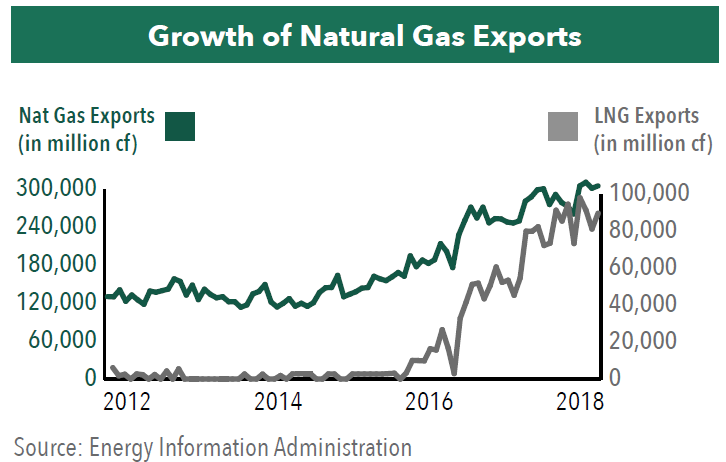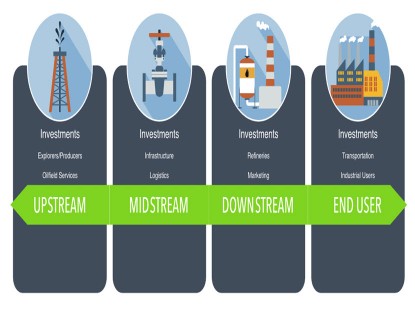Robust Growth in the Natural Gas Market
In the following commentary, Portfolio Manager Ryan Kelley discusses the drivers behind the strong growth in the natural gas market in 2018, how tight inventories might cause more volatility in the gas price and the outlook for continued growth in natural gas exports.
-
 Ryan C. Kelley, CFAChief Investment Officer and Portfolio Manager
Ryan C. Kelley, CFAChief Investment Officer and Portfolio Manager -
 L. Joshua Wein, CAIAPortfolio Manager
L. Joshua Wein, CAIAPortfolio Manager
U.S. production and consumption of natural gas posted robust growth in 2018. What has been driving this growth and how is it benefiting Fund holdings?
Strong growth in demand for natural gas in 2018 originated from two main sources: the U.S. electric power industry and overseas customers. The electrical power generation industry continues to switch from using coal to cheaper, cleaner-burning natural gas to fire its plants. Consumption of natural gas by electric utilities was up 17% in the first nine months of 2018, while coal consumption was down 5% through August.

Meanwhile, export demand continues to grow. Liquefied natural gas (LNG) exports were up 50% year over year in November, driven by strong demand from China and Europe, and pipeline exports to Mexico were up 12%. A colder start to the winter also bolstered residential demand for natural gas.
The pipeline and gas distribution companies in the Fund have benefited from volume growth in the natural gas market, as revenues and earnings for these companies are predominantly tied to volume throughput. Historically, earnings per share (EPS) growth for utilities has averaged 3-5% annually. However, EPS for the Utility sector is forecast to grow at closer to 5-7% per year over the next five years thanks to strong demand for natural gas as well as the effects of infrastructure replacement and modernization.
Natural gas prices spiked in November as a result of strong domestic and export demand, leading to a decline in inventories. Could the low inventory position last through the winter? What is your outlook for the price of natural gas?
The price of natural gas spiked to over $4.50/million British thermal unit (MMBtu) in November in reaction to reports that inventories were 20% below their five-year average. Inventories have been low in 2018 as a result of high usage, and the cold start to this winter heating season tipped the market into a condition of very tight supply. The market for natural gas today is finely balanced. Consumption together with net exports roughly equal production, so it is difficult for the industry to build inventory. We expect the price of natural gas to remain above $3/MMBtu for the current heating season. And because the market has a lower inventory cushion, investors should expect more volatility in natural gas prices this winter, as the market reacts more sharply than usual to weather events.
Would you please discuss the growth of natural gas exports over the last few years and your outlook for natural gas exports going forward?
Growth in exports of natural gas has accelerated significantly since 2016 when the U.S. first began to export LNG. In the last two years, exports of natural gas have jumped over 60%, with almost three quarters of the growth coming from increased exports of LNG and the rest coming from growth in pipeline exports to Mexico. We anticipate the growth to continue in 2019 with LNG exports and pipeline exports to Mexico expected to rise almost 80% and 16%, respectively.
Industry commentators forecast tremendous growth in LNG exports from the U.S. in the years ahead, with terminal export capacity set to increase 8-fold over the next decade, just in time to meet growing demand from China, India and Japan. The U.S. is expected to be the largest exporter of LNG in the world by 2023.
Would you please discuss your outlook for growth in the natural gas market?
We believe the fundamentals of the natural gas market remain compelling. Growth in production and consumption is expected to drive above-average growth in EPS for many of the stocks in the Fund over the next few years. Meanwhile, average valuations have come down with the market; the stocks in the Fund are trading on 17x trailing earnings (December 31, 2018) vs. 23x twelve months ago. Should economic growth slow, investors are likely to look favorably on utility-type investments given their more predictable, less economically sensitive earnings streams. High dividend yields relative to the general market should also contribute to good returns; 45 out of the 50 holdings in the Fund currently pay a dividend.
- In this article:
- Energy
- Gas Utility Fund
You might also like
-
 Investment Idea
Investment IdeaDefining the Energy "Value Chain"
 Ben Cook, CFAPortfolio ManagerRead the Investment Idea
Ben Cook, CFAPortfolio ManagerRead the Investment IdeaEnergy is a large and complex sector. The sector’s broad sub-industries can be divided into a “value chain,” each segment of which has different characteristics and offers different investment opportunities.
-
 Portfolio Perspective
Portfolio Perspective
Energy Transition FundEnergy - Attractively Valued Sector with Higher Free Cash Flow Yields
 L. Joshua Wein, CAIAPortfolio Manager
L. Joshua Wein, CAIAPortfolio Manager Ben Cook, CFAPortfolio ManagerRead the Commentary
Ben Cook, CFAPortfolio ManagerRead the CommentaryIn the following commentary, Portfolio Manager Ben Cook and Josh Wein discuss the Fund’s disciplined process throughout the volatility driven by tariff uncertainty and geopolitical developments.
-
 Portfolio Perspective
Portfolio Perspective
Gas Utility FundNatural Gas: Essential to Reliable Power
 Ryan C. Kelley, CFAChief Investment Officer and Portfolio Manager
Ryan C. Kelley, CFAChief Investment Officer and Portfolio Manager L. Joshua Wein, CAIAPortfolio ManagerRead the Commentary
L. Joshua Wein, CAIAPortfolio ManagerRead the CommentaryUtilities have delivered strong returns in 2025, fueled by demand trends, earnings growth and their defensive nature, positioning natural gas utilities as a compelling opportunity amid market uncertainty.
